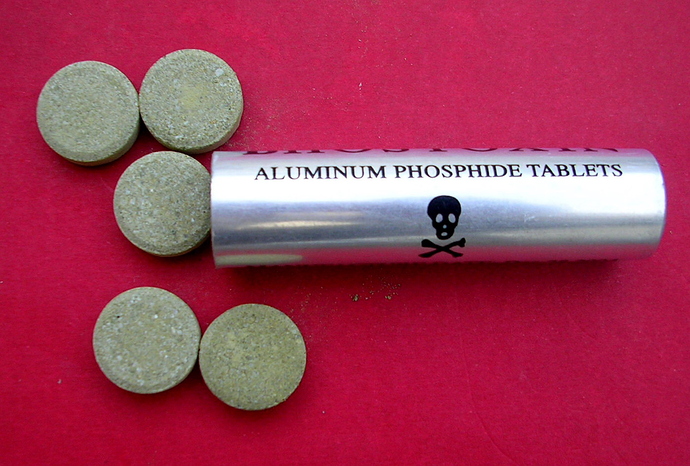Aluminium Phosphide :
- Commonly used in India and Iran as insecticide and rodenticide
- One of the most common causes of poisoning deaths alongside Organo-Phosphorus poisoning
- No effective antidote
- Modes of poisoning - inhalation and Ingestion
-
ALP comes in contact with moisture - Phosphine gas
-
Gastric acid juice accelerates this conversion of aluminium phosphide into phosphine gas - gets absorbed in GIT and inhibits cytochrome oxidase and inhibits electron chain and oxidative phosphorylation and results in energy crisis in cell.
-
It induces oxidative stress and boosts extra mitochondrial release of free oxygen radicals that results in lipid peroxidation and denaturation of cell membrane in various organs. Also reduces glutathione, one of the main antioxidant defences
-
Multi-organ involvement
Symptoms :
Early - nausea, vomiting, hematemesis, retrosternal and epigastric pain(GI symptoms), anxiety, agitation, and garlic breath (characterisitc of phosphine gas)
Inhalational symptoms - Tachypnoea, dyspnoea, crepitations and rhonchi are common signs of respiratory toxicity.
Patients often develop both routes of toxicity as they inhale phosphine gas they regurgitate and after blood phosphine levels reach critical value, its just a matter of time before it involves all the organs and toxicity and cell death results. Hence early diagnosing of organ damage plays a pivotal role in survival rate of the patient.
Fatal signs : shock and peripheral circulatory failure
Diagnosis :
- Clincal suspicion (Most cases after poisoning of unknown causes and death, in autopsy reveal aluminium phosphide poisoning)
- Gas Chromatography ( Most specific and sensitive)
- Silver nitrate test
- Ammonium molybdate test
Management :
- No specific antidote
- limited treatment modalities available
- Supportive treatment
- In cases of inhalation poisoning, the patient should be transferred to a well-ventilated space or fresh air. Contaminated clothes should be removed and skin and eyes washed with tap water immediately.
- Early Cardiac monitoring to prevent refractory hypotension and Cardiac arrhthymias
First emergency step : Gastric lavage with potassium permanganate, activated
charcoal+sorbitol solution, and coconut oil can be performed
- Potassium permanganate (1:10 000 solution) oxidises phosphine gas in the stomach to phosphate, and reduces the amount of lethal phosphine gas
- The acidic environment of the stomach stimulates the conversion of AlP to phosphine gas, and lavage with sodium bicarbonate can be helpful
- Coconut oil - form a protective layer around the gastric mucosa and prevent the absorption of phosphine gas and may dilute HCl in the stomach and reduce the breakdown of phosphide.
- Magnesium Sulphate supplementation has a contradicting evidences of its use.
- N-acetylcysteine - replenishes cellular glutathione and magnesium, in addition to its antioxidant properties and increases survival time and reduces the risk of myocardial oxidative injury.
Prognosis :
It’s bad in case of development of hyperglycemia, hyperurinemia, hyperleukocytosis, high simplified acute physiology score (SAPS II), hypotension, acidosis, leukocytosis, hyperuraemia, ECG abnormalities, high acute physiology and chronic health evaluation score (APACHE II), low Glasgow coma scale, acute renal failure, low prothrombin rate,
hyperleukocytosis, methaemoglobinaemia and lack of vomiting after ingestion.
In survivors (very few ), neurological manifestations are common and dyshphagia, oesphageal strictures and tracheo-oesophageal strictures are also seen
